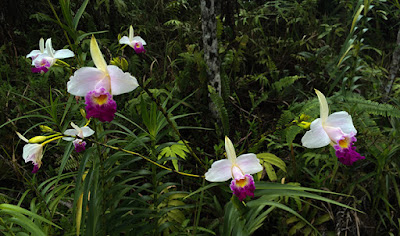Gunung Penrissen (top) and the Kalimantan Barat valley (bottom) as seen from the official viewpoint area.
It is much cooler in this region due to the elevation and the persistent fog (you can see some of that misty weather in the shot above). There are many stunning tree ferns (the genus Cyathea) as well as huge Zingiberaceae specimens to be seen during the hike. The predominant tree fern species is probably Cyathea latebrosa, although one may need to have a closer look to be certain considering the variation and uncertainty presented by species in this genus. There's a closely related species named Cyathea wallacei which may be present here as well.
Cyathea latebrosa
The climate here is very conducive for many orchid species, but we went at the time when not many were flowering. We only saw only three orchid species in flower, two of which were identifiable.
1. Arundina graminifolia
Zoomed out photo of Arundina graminifolia clusters with Cyathea latebrosa in the background.
2. Dendrobium paathii
3. Eria sp.? (mass flowering high up in the trees)
4. Dendrobium sp.?
5. Oberonia sp.?
6. Coelogyne odoardi ? (lithophytic)
7. ?? (litophytic)
8. Jewel orchid ? (terrestrial)



















